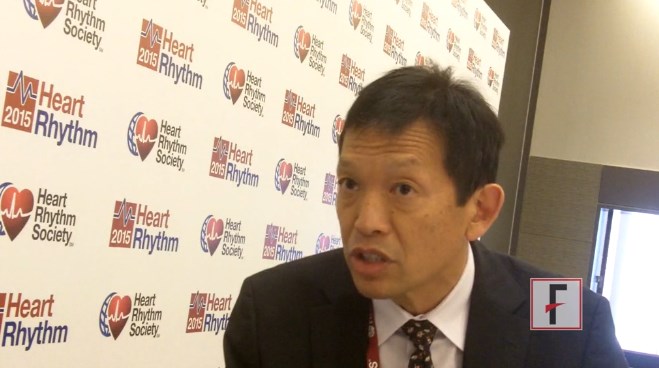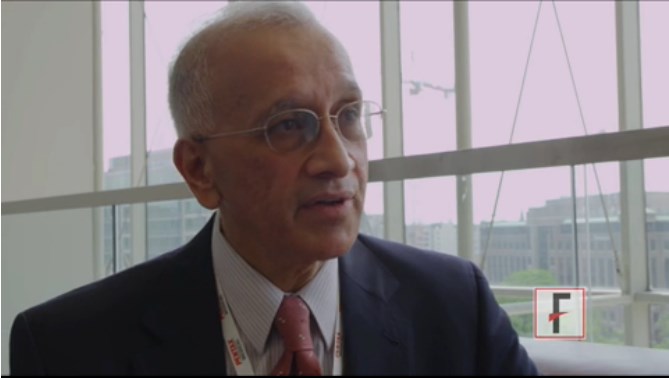User login
VIDEO: Level of e-cigarette power contributes to potentially hazardous effects
DENVER – The higher the power of an e-cigarette, the higher the concentrations of potentially hazardous substances the device produces, including acetaldehyde, acrolein, and formaldehyde.
Those are among the findings presented at an international conference of the American Thoracic Society by lead study author Dr. Daniel Sullivan, an internal medicine resident at the University of Texas Southwestern Medical Center. During his previous training at the University of Alabama, Birmingham, Dr. Sullivan and his associates used a variety of methods including liquid chromatography–mass spectrometry and enzyme-linked immunosorbent assay (ELISA) to study components and nicotine formulations typical of e-cigarette users. Under some test conditions, formaldehyde levels were comparable to those seen in traditional tobacco cigarettes, he said in a video interview.
Dr. Sullivan reported having no relevant financial conflicts.
The video associated with this article is no longer available on this site. Please view all of our videos on the MDedge YouTube channel
On Twitter @dougbrunk
DENVER – The higher the power of an e-cigarette, the higher the concentrations of potentially hazardous substances the device produces, including acetaldehyde, acrolein, and formaldehyde.
Those are among the findings presented at an international conference of the American Thoracic Society by lead study author Dr. Daniel Sullivan, an internal medicine resident at the University of Texas Southwestern Medical Center. During his previous training at the University of Alabama, Birmingham, Dr. Sullivan and his associates used a variety of methods including liquid chromatography–mass spectrometry and enzyme-linked immunosorbent assay (ELISA) to study components and nicotine formulations typical of e-cigarette users. Under some test conditions, formaldehyde levels were comparable to those seen in traditional tobacco cigarettes, he said in a video interview.
Dr. Sullivan reported having no relevant financial conflicts.
The video associated with this article is no longer available on this site. Please view all of our videos on the MDedge YouTube channel
On Twitter @dougbrunk
DENVER – The higher the power of an e-cigarette, the higher the concentrations of potentially hazardous substances the device produces, including acetaldehyde, acrolein, and formaldehyde.
Those are among the findings presented at an international conference of the American Thoracic Society by lead study author Dr. Daniel Sullivan, an internal medicine resident at the University of Texas Southwestern Medical Center. During his previous training at the University of Alabama, Birmingham, Dr. Sullivan and his associates used a variety of methods including liquid chromatography–mass spectrometry and enzyme-linked immunosorbent assay (ELISA) to study components and nicotine formulations typical of e-cigarette users. Under some test conditions, formaldehyde levels were comparable to those seen in traditional tobacco cigarettes, he said in a video interview.
Dr. Sullivan reported having no relevant financial conflicts.
The video associated with this article is no longer available on this site. Please view all of our videos on the MDedge YouTube channel
On Twitter @dougbrunk
AT ATS 2015
DDW: Scheduled for a colonoscopy? Pass the pretzels!
WASHINGTON – A novel, edible colon preparation could make obsolete the fasting and large volume of salty liquid cleansing that keep many a patient from completing their colonoscopies.
A pilot study showed that all 10 patients who ate a series of nutritionally balanced meals, drinks, and snacks such as pretzels and pudding had a successful colon cleansing according to the endoscopist at the time of the procedure, Dr. L. Campbell Levy of Dartmouth-Hitchcock Medical Center in Lebanon, N.H., reported at the annual Digestive Disease Week.
The preparation, which is blended with polyethylene glycol 3350, sorbitol, and ascorbic acid, did not produce any significant changes in electrolytes or creatinine.
There were no adverse events and, equally important, all 10 patients said that they would follow the edible bowel regimen again for a subsequent procedure.
In a video interview, he discussed the small study’s results and the plans for larger, randomized studies.
Dr. Levy reported no relevant conflicts. The inventor of the diet and the founder of Colonary Concepts were involved in the study.
The video associated with this article is no longer available on this site. Please view all of our videos on the MDedge YouTube channel
On Twitter @pwendl
WASHINGTON – A novel, edible colon preparation could make obsolete the fasting and large volume of salty liquid cleansing that keep many a patient from completing their colonoscopies.
A pilot study showed that all 10 patients who ate a series of nutritionally balanced meals, drinks, and snacks such as pretzels and pudding had a successful colon cleansing according to the endoscopist at the time of the procedure, Dr. L. Campbell Levy of Dartmouth-Hitchcock Medical Center in Lebanon, N.H., reported at the annual Digestive Disease Week.
The preparation, which is blended with polyethylene glycol 3350, sorbitol, and ascorbic acid, did not produce any significant changes in electrolytes or creatinine.
There were no adverse events and, equally important, all 10 patients said that they would follow the edible bowel regimen again for a subsequent procedure.
In a video interview, he discussed the small study’s results and the plans for larger, randomized studies.
Dr. Levy reported no relevant conflicts. The inventor of the diet and the founder of Colonary Concepts were involved in the study.
The video associated with this article is no longer available on this site. Please view all of our videos on the MDedge YouTube channel
On Twitter @pwendl
WASHINGTON – A novel, edible colon preparation could make obsolete the fasting and large volume of salty liquid cleansing that keep many a patient from completing their colonoscopies.
A pilot study showed that all 10 patients who ate a series of nutritionally balanced meals, drinks, and snacks such as pretzels and pudding had a successful colon cleansing according to the endoscopist at the time of the procedure, Dr. L. Campbell Levy of Dartmouth-Hitchcock Medical Center in Lebanon, N.H., reported at the annual Digestive Disease Week.
The preparation, which is blended with polyethylene glycol 3350, sorbitol, and ascorbic acid, did not produce any significant changes in electrolytes or creatinine.
There were no adverse events and, equally important, all 10 patients said that they would follow the edible bowel regimen again for a subsequent procedure.
In a video interview, he discussed the small study’s results and the plans for larger, randomized studies.
Dr. Levy reported no relevant conflicts. The inventor of the diet and the founder of Colonary Concepts were involved in the study.
The video associated with this article is no longer available on this site. Please view all of our videos on the MDedge YouTube channel
On Twitter @pwendl
AT DDW® 2015
VIDEO: E-cigarettes lack long-term data for smoking cessation
DENVER – Although electronic cigarettes are widely promoted as a smoking cessation tool, no sound data exist to support their use beyond 1 month as a way to kick the smoking habit, results from the largest meta-analysis of its kind suggest.
In an interview at an international conference of the America Thoracic Society, study author Dr. Matthew B. Stanbrook highlighted results from the review, which included 297 articles published to May 2014.
The meta-analysis showed that point prevalence abstinence was significantly better for e-cigarettes, compared with placebo, at 1 month (relative risk, 1.71). That effect, however, was no longer observed at 3- or 6-month follow-ups.
The most common adverse events noted in the studies were dry cough, throat irritation, and shortness of breath.
Dr. Stanbrook reported having no relevant financial conflicts.
The video associated with this article is no longer available on this site. Please view all of our videos on the MDedge YouTube channel
On Twitter @dougbrunk
DENVER – Although electronic cigarettes are widely promoted as a smoking cessation tool, no sound data exist to support their use beyond 1 month as a way to kick the smoking habit, results from the largest meta-analysis of its kind suggest.
In an interview at an international conference of the America Thoracic Society, study author Dr. Matthew B. Stanbrook highlighted results from the review, which included 297 articles published to May 2014.
The meta-analysis showed that point prevalence abstinence was significantly better for e-cigarettes, compared with placebo, at 1 month (relative risk, 1.71). That effect, however, was no longer observed at 3- or 6-month follow-ups.
The most common adverse events noted in the studies were dry cough, throat irritation, and shortness of breath.
Dr. Stanbrook reported having no relevant financial conflicts.
The video associated with this article is no longer available on this site. Please view all of our videos on the MDedge YouTube channel
On Twitter @dougbrunk
DENVER – Although electronic cigarettes are widely promoted as a smoking cessation tool, no sound data exist to support their use beyond 1 month as a way to kick the smoking habit, results from the largest meta-analysis of its kind suggest.
In an interview at an international conference of the America Thoracic Society, study author Dr. Matthew B. Stanbrook highlighted results from the review, which included 297 articles published to May 2014.
The meta-analysis showed that point prevalence abstinence was significantly better for e-cigarettes, compared with placebo, at 1 month (relative risk, 1.71). That effect, however, was no longer observed at 3- or 6-month follow-ups.
The most common adverse events noted in the studies were dry cough, throat irritation, and shortness of breath.
Dr. Stanbrook reported having no relevant financial conflicts.
The video associated with this article is no longer available on this site. Please view all of our videos on the MDedge YouTube channel
On Twitter @dougbrunk
AT ATS 2015
VIDEO: MRI-compatible ICDs represent important advance
BOSTON – The prospect of soon having two new, different options for placing implantable cardioverter defibrillators (ICDs) that can safely undergo MRI exposure is “really important,” Dr. Fred M. Kusumoto said in an interview at the annual scientific sessions of the Heart Rhythm Society.
Researchers presented results from two independent, pivotal trials that showed the safety and efficacy of one of the new devices in patients who underwent MRI with 1.5 Tesla imagers.
Once the devices come onto the U.S. market they will likely be placed first in younger patients as well as older patients who seem likely to need MRI in the foreseeable future. As electrophysiologists grow more comfortable with the MRI-compatible ICDs, their use will gradually become more commonplace, Dr. Kusumoto predicted. That’s what happened when MRI-compatible pacemakers first became available, noted Dr. Kusumoto, professor of medicine and an electrophysiologist at the Mayo Clinic in Jacksonvile, Fla.
The next frontier for MRI-compatible implanted cardiac devices will be cardiac resynchronization therapy units, but with their more complicated design and lead placement that step will pose additional design and engineering challenges, he said.
Dr. Kusumoto had no relevant disclosures.
The video associated with this article is no longer available on this site. Please view all of our videos on the MDedge YouTube channel
On Twitter @mitchelzoler
This article was updated 5/18/2015.
BOSTON – The prospect of soon having two new, different options for placing implantable cardioverter defibrillators (ICDs) that can safely undergo MRI exposure is “really important,” Dr. Fred M. Kusumoto said in an interview at the annual scientific sessions of the Heart Rhythm Society.
Researchers presented results from two independent, pivotal trials that showed the safety and efficacy of one of the new devices in patients who underwent MRI with 1.5 Tesla imagers.
Once the devices come onto the U.S. market they will likely be placed first in younger patients as well as older patients who seem likely to need MRI in the foreseeable future. As electrophysiologists grow more comfortable with the MRI-compatible ICDs, their use will gradually become more commonplace, Dr. Kusumoto predicted. That’s what happened when MRI-compatible pacemakers first became available, noted Dr. Kusumoto, professor of medicine and an electrophysiologist at the Mayo Clinic in Jacksonvile, Fla.
The next frontier for MRI-compatible implanted cardiac devices will be cardiac resynchronization therapy units, but with their more complicated design and lead placement that step will pose additional design and engineering challenges, he said.
Dr. Kusumoto had no relevant disclosures.
The video associated with this article is no longer available on this site. Please view all of our videos on the MDedge YouTube channel
On Twitter @mitchelzoler
This article was updated 5/18/2015.
BOSTON – The prospect of soon having two new, different options for placing implantable cardioverter defibrillators (ICDs) that can safely undergo MRI exposure is “really important,” Dr. Fred M. Kusumoto said in an interview at the annual scientific sessions of the Heart Rhythm Society.
Researchers presented results from two independent, pivotal trials that showed the safety and efficacy of one of the new devices in patients who underwent MRI with 1.5 Tesla imagers.
Once the devices come onto the U.S. market they will likely be placed first in younger patients as well as older patients who seem likely to need MRI in the foreseeable future. As electrophysiologists grow more comfortable with the MRI-compatible ICDs, their use will gradually become more commonplace, Dr. Kusumoto predicted. That’s what happened when MRI-compatible pacemakers first became available, noted Dr. Kusumoto, professor of medicine and an electrophysiologist at the Mayo Clinic in Jacksonvile, Fla.
The next frontier for MRI-compatible implanted cardiac devices will be cardiac resynchronization therapy units, but with their more complicated design and lead placement that step will pose additional design and engineering challenges, he said.
Dr. Kusumoto had no relevant disclosures.
The video associated with this article is no longer available on this site. Please view all of our videos on the MDedge YouTube channel
On Twitter @mitchelzoler
This article was updated 5/18/2015.
AT HEART RHYTHM 2015
DDW: VIDEO: What we don’t know in the management of liver disease and coagulopathy
WASHINGTON – Your patient has cirrhosis, platelets 60,000 mm3, an INR of 2.0, serum creatinine of 1.2 mg/dL, and requires an endoscopic retrograde cholangiopancreatography with sphincterotomy.
What do you do next?
Management of a patient such as this is challenging, but not just because of the long-perceived risk for bleeding, Dr. Patrick S. Kamath of the Mayo Clinic in Rochester, Minn., said during a clinical symposium at the annual Digestive Disease Week.
Several other factors must be considered, including the clotting risk in patients with liver disease and the fact that procedure-related bleeding risk cannot be adequately determined preprocedure. Transfusions also carry their own dangers in this patient population and should be approached with caution, he said.
To hear more from this world-renowned liver expert, check out our interview as we sat down with Dr. Kamath at this year’s DDW.
Dr. Kamath reported no relevant financial conflicts.
The video associated with this article is no longer available on this site. Please view all of our videos on the MDedge YouTube channel
On Twitter @pwendl
WASHINGTON – Your patient has cirrhosis, platelets 60,000 mm3, an INR of 2.0, serum creatinine of 1.2 mg/dL, and requires an endoscopic retrograde cholangiopancreatography with sphincterotomy.
What do you do next?
Management of a patient such as this is challenging, but not just because of the long-perceived risk for bleeding, Dr. Patrick S. Kamath of the Mayo Clinic in Rochester, Minn., said during a clinical symposium at the annual Digestive Disease Week.
Several other factors must be considered, including the clotting risk in patients with liver disease and the fact that procedure-related bleeding risk cannot be adequately determined preprocedure. Transfusions also carry their own dangers in this patient population and should be approached with caution, he said.
To hear more from this world-renowned liver expert, check out our interview as we sat down with Dr. Kamath at this year’s DDW.
Dr. Kamath reported no relevant financial conflicts.
The video associated with this article is no longer available on this site. Please view all of our videos on the MDedge YouTube channel
On Twitter @pwendl
WASHINGTON – Your patient has cirrhosis, platelets 60,000 mm3, an INR of 2.0, serum creatinine of 1.2 mg/dL, and requires an endoscopic retrograde cholangiopancreatography with sphincterotomy.
What do you do next?
Management of a patient such as this is challenging, but not just because of the long-perceived risk for bleeding, Dr. Patrick S. Kamath of the Mayo Clinic in Rochester, Minn., said during a clinical symposium at the annual Digestive Disease Week.
Several other factors must be considered, including the clotting risk in patients with liver disease and the fact that procedure-related bleeding risk cannot be adequately determined preprocedure. Transfusions also carry their own dangers in this patient population and should be approached with caution, he said.
To hear more from this world-renowned liver expert, check out our interview as we sat down with Dr. Kamath at this year’s DDW.
Dr. Kamath reported no relevant financial conflicts.
The video associated with this article is no longer available on this site. Please view all of our videos on the MDedge YouTube channel
On Twitter @pwendl
AT DDW 2015
VIDEO: Remote monitoring of cardiac devices cuts hospitalizations
BOSTON – Remote monitoring of cardiovascular implantable electronic devices dramatically improved patient outcomes and cut health care costs by keeping patients out of the hospital and reducing lengths of stays when hospitalization was needed, a retrospective analysis showed.
Remote monitoring “led to improved outcomes, more convenience for patients, and saved money, truly a win-win-win,” in the study of real-world data collected on more than 92,000 U.S. patients during 2008-2013, said Dr. Jonathan P. Piccini Sr. in an interview at the annual scientific sessions of the Heart Rhythm Society.
Using the MarketScan database of U.S. patients covered by commercial insurance or Medicare, Dr. Piccini and his associates analyzed hospitalization records for 92,566 patients who received an implanted pacemaker, implantable cardioverter defibrillator, or cardiac resynchronization device during the study period. Roughly a third of the patients underwent remote monitoring along with their routine clinic visits while the rest were followed exclusively by clinic visits.
The data showed that remotely monitored patients had a statistically significant 18% lower rate of hospitalizations during follow-up and a 35% cut in their average length of stay when hospitalized. This resulted in a 30% drop in hospitalization costs, compared with costs for similar patients who did not undergo remote monitoring of their implanted devices. The cost savings remote monitoring produced meant that every 100,000 patient-years of remote monitoring saved about $370 million in hospital costs.
Coincident with the meeting, an expert panel of the Heart Rhythm Society released a statement on remote monitoring for cardiovascular implantable electronic devices (CIEDs) (Heart Rhythm 2015 [doi: 10.1016/j.hrthm.2015.05.008]. The statement said that “remote monitoring represents the new standard of care for patients with CIEDs.” But Dr. Piccini’s findings showed that U.S. clinicians vastly underused remote monitoring, with two-thirds of U.S. CIED recipients failing to undergo remote monitoring during 2008-2013. “Increased monitoring is a huge opportunity for health care improvement,” said Dr. Piccini, a cardiologist and an electrophysiologist at Duke University in Durham, N.C.
Dr. Piccini has been a consultant to Medtronic and has received research grants from Boston Scientific.
The video associated with this article is no longer available on this site. Please view all of our videos on the MDedge YouTube channel
Twitter @mitchelzoler
BOSTON – Remote monitoring of cardiovascular implantable electronic devices dramatically improved patient outcomes and cut health care costs by keeping patients out of the hospital and reducing lengths of stays when hospitalization was needed, a retrospective analysis showed.
Remote monitoring “led to improved outcomes, more convenience for patients, and saved money, truly a win-win-win,” in the study of real-world data collected on more than 92,000 U.S. patients during 2008-2013, said Dr. Jonathan P. Piccini Sr. in an interview at the annual scientific sessions of the Heart Rhythm Society.
Using the MarketScan database of U.S. patients covered by commercial insurance or Medicare, Dr. Piccini and his associates analyzed hospitalization records for 92,566 patients who received an implanted pacemaker, implantable cardioverter defibrillator, or cardiac resynchronization device during the study period. Roughly a third of the patients underwent remote monitoring along with their routine clinic visits while the rest were followed exclusively by clinic visits.
The data showed that remotely monitored patients had a statistically significant 18% lower rate of hospitalizations during follow-up and a 35% cut in their average length of stay when hospitalized. This resulted in a 30% drop in hospitalization costs, compared with costs for similar patients who did not undergo remote monitoring of their implanted devices. The cost savings remote monitoring produced meant that every 100,000 patient-years of remote monitoring saved about $370 million in hospital costs.
Coincident with the meeting, an expert panel of the Heart Rhythm Society released a statement on remote monitoring for cardiovascular implantable electronic devices (CIEDs) (Heart Rhythm 2015 [doi: 10.1016/j.hrthm.2015.05.008]. The statement said that “remote monitoring represents the new standard of care for patients with CIEDs.” But Dr. Piccini’s findings showed that U.S. clinicians vastly underused remote monitoring, with two-thirds of U.S. CIED recipients failing to undergo remote monitoring during 2008-2013. “Increased monitoring is a huge opportunity for health care improvement,” said Dr. Piccini, a cardiologist and an electrophysiologist at Duke University in Durham, N.C.
Dr. Piccini has been a consultant to Medtronic and has received research grants from Boston Scientific.
The video associated with this article is no longer available on this site. Please view all of our videos on the MDedge YouTube channel
Twitter @mitchelzoler
BOSTON – Remote monitoring of cardiovascular implantable electronic devices dramatically improved patient outcomes and cut health care costs by keeping patients out of the hospital and reducing lengths of stays when hospitalization was needed, a retrospective analysis showed.
Remote monitoring “led to improved outcomes, more convenience for patients, and saved money, truly a win-win-win,” in the study of real-world data collected on more than 92,000 U.S. patients during 2008-2013, said Dr. Jonathan P. Piccini Sr. in an interview at the annual scientific sessions of the Heart Rhythm Society.
Using the MarketScan database of U.S. patients covered by commercial insurance or Medicare, Dr. Piccini and his associates analyzed hospitalization records for 92,566 patients who received an implanted pacemaker, implantable cardioverter defibrillator, or cardiac resynchronization device during the study period. Roughly a third of the patients underwent remote monitoring along with their routine clinic visits while the rest were followed exclusively by clinic visits.
The data showed that remotely monitored patients had a statistically significant 18% lower rate of hospitalizations during follow-up and a 35% cut in their average length of stay when hospitalized. This resulted in a 30% drop in hospitalization costs, compared with costs for similar patients who did not undergo remote monitoring of their implanted devices. The cost savings remote monitoring produced meant that every 100,000 patient-years of remote monitoring saved about $370 million in hospital costs.
Coincident with the meeting, an expert panel of the Heart Rhythm Society released a statement on remote monitoring for cardiovascular implantable electronic devices (CIEDs) (Heart Rhythm 2015 [doi: 10.1016/j.hrthm.2015.05.008]. The statement said that “remote monitoring represents the new standard of care for patients with CIEDs.” But Dr. Piccini’s findings showed that U.S. clinicians vastly underused remote monitoring, with two-thirds of U.S. CIED recipients failing to undergo remote monitoring during 2008-2013. “Increased monitoring is a huge opportunity for health care improvement,” said Dr. Piccini, a cardiologist and an electrophysiologist at Duke University in Durham, N.C.
Dr. Piccini has been a consultant to Medtronic and has received research grants from Boston Scientific.
The video associated with this article is no longer available on this site. Please view all of our videos on the MDedge YouTube channel
Twitter @mitchelzoler
AT HEART RHYTHM 2015
VIDEO: Patient-generated health tests pose challenges, opportunities for doctors
CHICAGO – Technology advances are giving patients direct access to myriad health tests and their own health data, but what role do physicians have in responding to such patient-generated assessments?
Dr. Marc Triola of New York University in New York says that the growing reach of health care technology presents both challenges and opportunities for the physician-patient relationship. Dr. Triola spoke at the annual meeting of the American Medical Women’s Association about how physicians can embrace technology and use advancements to improve quality of care.
In this video interview, Dr. Triola speaks about the new ways in which patients can assess their own health data and how doctors should address the test results. He also discusses barriers posed by new technology and how physicians can help shape the changing delivery of health care.
The video associated with this article is no longer available on this site. Please view all of our videos on the MDedge YouTube channel
On Twitter @legal_med
CHICAGO – Technology advances are giving patients direct access to myriad health tests and their own health data, but what role do physicians have in responding to such patient-generated assessments?
Dr. Marc Triola of New York University in New York says that the growing reach of health care technology presents both challenges and opportunities for the physician-patient relationship. Dr. Triola spoke at the annual meeting of the American Medical Women’s Association about how physicians can embrace technology and use advancements to improve quality of care.
In this video interview, Dr. Triola speaks about the new ways in which patients can assess their own health data and how doctors should address the test results. He also discusses barriers posed by new technology and how physicians can help shape the changing delivery of health care.
The video associated with this article is no longer available on this site. Please view all of our videos on the MDedge YouTube channel
On Twitter @legal_med
CHICAGO – Technology advances are giving patients direct access to myriad health tests and their own health data, but what role do physicians have in responding to such patient-generated assessments?
Dr. Marc Triola of New York University in New York says that the growing reach of health care technology presents both challenges and opportunities for the physician-patient relationship. Dr. Triola spoke at the annual meeting of the American Medical Women’s Association about how physicians can embrace technology and use advancements to improve quality of care.
In this video interview, Dr. Triola speaks about the new ways in which patients can assess their own health data and how doctors should address the test results. He also discusses barriers posed by new technology and how physicians can help shape the changing delivery of health care.
The video associated with this article is no longer available on this site. Please view all of our videos on the MDedge YouTube channel
On Twitter @legal_med
AT THE AMWA ANNUAL MEETING
VIDEO: Get excited about the excimer laser for dermatitis
ASHEVILLE, N.C. – Excimer lasers can be used for patients with allergic contact dermatitis for whom topical therapies are unsuccessful or undesirable, according to Dr. Alison Ehrlich of George Washington University in Washington.
In an interview at the annual meeting of the Noah Worcester Dermatological Society, Dr. Ehrlich discussed her use of the excimer laser for dermatitis patients and shared some tips for successful treatment.
The video associated with this article is no longer available on this site. Please view all of our videos on the MDedge YouTube channel
ASHEVILLE, N.C. – Excimer lasers can be used for patients with allergic contact dermatitis for whom topical therapies are unsuccessful or undesirable, according to Dr. Alison Ehrlich of George Washington University in Washington.
In an interview at the annual meeting of the Noah Worcester Dermatological Society, Dr. Ehrlich discussed her use of the excimer laser for dermatitis patients and shared some tips for successful treatment.
The video associated with this article is no longer available on this site. Please view all of our videos on the MDedge YouTube channel
ASHEVILLE, N.C. – Excimer lasers can be used for patients with allergic contact dermatitis for whom topical therapies are unsuccessful or undesirable, according to Dr. Alison Ehrlich of George Washington University in Washington.
In an interview at the annual meeting of the Noah Worcester Dermatological Society, Dr. Ehrlich discussed her use of the excimer laser for dermatitis patients and shared some tips for successful treatment.
The video associated with this article is no longer available on this site. Please view all of our videos on the MDedge YouTube channel
AT NOAH 57
VIDEO: Dermatologists should embrace tissue adhesive
ASHEVILLE, N.C. – Cutaneous adhesives have many advantages in dermatologic surgery, according to Dr. John West of Seaport Dermatology and Mohs Surgery in Mystic, Conn.
In a video interview at the annual meeting of the Noah Worcester Dermatological Society, Dr. West explained some of the benefits of tissue adhesives for both doctors and patients and shared several pearls for optimal use of these products.
The video associated with this article is no longer available on this site. Please view all of our videos on the MDedge YouTube channel
ASHEVILLE, N.C. – Cutaneous adhesives have many advantages in dermatologic surgery, according to Dr. John West of Seaport Dermatology and Mohs Surgery in Mystic, Conn.
In a video interview at the annual meeting of the Noah Worcester Dermatological Society, Dr. West explained some of the benefits of tissue adhesives for both doctors and patients and shared several pearls for optimal use of these products.
The video associated with this article is no longer available on this site. Please view all of our videos on the MDedge YouTube channel
ASHEVILLE, N.C. – Cutaneous adhesives have many advantages in dermatologic surgery, according to Dr. John West of Seaport Dermatology and Mohs Surgery in Mystic, Conn.
In a video interview at the annual meeting of the Noah Worcester Dermatological Society, Dr. West explained some of the benefits of tissue adhesives for both doctors and patients and shared several pearls for optimal use of these products.
The video associated with this article is no longer available on this site. Please view all of our videos on the MDedge YouTube channel
AT NOAH 57
Update on Psoriasis Comorbidities: Report From the AAD Meeting
At the 73rd Annual Meeting of the American Academy of Dermatology in San Francisco, California, Dr. Jashin J. Wu reviews data on the risk for cardiovascular and noncardiovascular comorbidities in psoriasis patients. He discusses patients with hypertension and how psoriasis disease severity impacts control of hypertension. Noncardiovascular comorbidities such as chronic obstructive pulmonary disease, gallstones, end-stage kidney disease, and others, are evaluated.
At the 73rd Annual Meeting of the American Academy of Dermatology in San Francisco, California, Dr. Jashin J. Wu reviews data on the risk for cardiovascular and noncardiovascular comorbidities in psoriasis patients. He discusses patients with hypertension and how psoriasis disease severity impacts control of hypertension. Noncardiovascular comorbidities such as chronic obstructive pulmonary disease, gallstones, end-stage kidney disease, and others, are evaluated.
At the 73rd Annual Meeting of the American Academy of Dermatology in San Francisco, California, Dr. Jashin J. Wu reviews data on the risk for cardiovascular and noncardiovascular comorbidities in psoriasis patients. He discusses patients with hypertension and how psoriasis disease severity impacts control of hypertension. Noncardiovascular comorbidities such as chronic obstructive pulmonary disease, gallstones, end-stage kidney disease, and others, are evaluated.









